|
|
|
|
|
|
|
|
|
 Posted: Sun Aug 05, 2012 11:59 am Posted: Sun Aug 05, 2012 11:59 am
Kiyamachi Dori Kiyamachi Dori is a special street known for the top quality restaurants and bars that are on it. After a previous destruction of the village this street was rezoned to be an entertainment street during the reconstruction period and has since boomed to become to the finest place to eat and drink in Konoha. Check below for the menus of the biggest shops. Ichiraku Ramen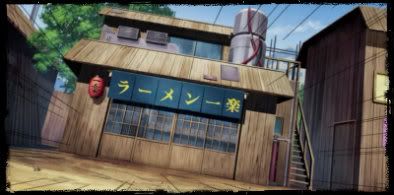 Konoha's Ichiraku Ramen is famous throughout the shinobi world for their delicious food, as well as extraordinary service. With over six hundred years of assured quality, the owner works hard to keep up the name. Although no longer owned by original family the food is still quite good. Occasionally, help is needed in the kitchens. Don't worry, the pay is good so keep an eye out for help requests! Owner: Yamanouchi Bakin (山之内 馬琴) Menu:Shio Ramen Soup
Probably the oldest of the four main ramen dishes, Shio Ramen Soup is a clear, almost transparent dish like the Chinese maotang, and is a simple chicken broth.
Price: Free, 2 posts
Heals: 10% CP
Tonkotsu (pork bone) Ramen Soup
Characteristically distinctive by a cloudy white appearance. It is similar to the Chinese baitang and is a thick broth made with crushed bones that have been boiled for hours. It is a specialty of Kyuushuu and is often served with beni shoga (pickled ginger).
Price: Free, 2 posts
Heals: 10% HP
Shooyu Ramen Soup
This dish is made by adding a soy-based sauce to a clear stock usually comprised of chicken and vegetables. A favoured seasoning is black pepper and this dish is popular in Honshuu.
Price: 1 ryo, 4 posts
Heals: 15% CP
Miso Ramen Soup
This unique Japanese ramen was developed in Hokkaido and features a broth that combines chicken with fermented soybean paste (miso). It is often topped with sweetcorn and butter.
Price: 1 ryo, 4 posts
Heals: 15% HP
Sapporo Miso Ramen Soup
Most Japanese people associate Sapporo with its rich miso ramen which was invented to deal with Hokkaido’s harsh, snowy winters. Sapporo miso ramen is usually topped with sweetcorn, butter, beansprouts, finely chopped pork, and garlic; sometimes with local seafood such as scallop, squid, and crab.
Price: 2 ryo, 3 posts
Heals: 20% CP
Kitakata Ramen Soup
Kitakata, located in northern Honshuu, is known for its rather thick, flat, curly noodles served in pork and niboshi broth.
Price: 2 ryo, 3 posts
Heals: 20% HP
Tokyo Style Ramen Soup
This dish consists of slightly thin, curly noodles served in a soy-flavoured chicken broth. The broth usually has a touch of dashi. Standard toppings included chopped scallion, menma, and sliced pork - along with kamaboko, egg, nori, and spinach.
Price: 3 ryo, 2 posts
Heals: 25% CP
Hakata Ramen Soup
Hakata Ramen Soup has a rich, milky, pork-bone tonkotsu broth and rather thin, non-curly and resilient noodles. Distinctive toppings such as beni shoga (pickled ginger), sesame seeds, and picked greens are left on tables for customers to serve themselves.
Price: 3 ryo, 2 posts
Heals: 25% HP
Nagasaki Champon Soup
Champon is topped with a variety of ingredients (mostly seafood) and is usually covered in a starchy sauce.
Price: 4 ryo, 1 post
Heals: 30% CP
Tantanmen Ramen Soup
The Japanese version of the Chinese dan dan noodles. It is served in a reddish, spicy chili and sesame soup, usually containing minced pork, chopped scallion, and chili - occasionally topped with a dash of spinach.
Price: 4 ryo, 1 post
Heals: 30% HP
|
 |
 |
|
|
|
|
|
|
|
|
|
|
|
|
 Posted: Sun Aug 05, 2012 12:10 pm Posted: Sun Aug 05, 2012 12:10 pm
Dangoya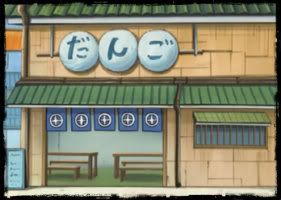 Dangoya is a popular, well-known shop in Konohagakure that's famous for its dango. The shop serves many other desserts that use dango in them, such as anmitsu, a popular Japanese dessert that is served in a bowl consisting of red bean paste (餡子, anko), small cubes of agar jelly, and pieces of fruit served with syrup. The shop's sign is in a form of a stick with white-coloured dango run through it. The hiragana for dango (だんご) is painted blue on them. The inside of the shop is simple with wooden tables, rectangular-shaped lights, and menus that hang all over the walls for customers to look at. Owner: Miyazawa "Dangoya" Yuriko (宮沢 百合子) Menu: Under Construction
Chadango:
Green-tea flavored Dango
Price:
Heal:
Bocchan dango:
Dango that has three colors. One is colored by red beans, the second by eggs, and the third by green tea.
Price:
Heal:
Denpun dango:
Variety of dango from Hokkaido made from potato flour and baked with sweet boiled beans
Price:
Heal:
Kuri dango:
Dango coated in chestnut paste
Price:
Heal:
Chichi dango:
Slightly-sweet light treats usually eaten as a dessert.
Price: 1 ryo, 1 post
Heal: 15% MHp
Hanami dango:
Also has three colors, Hanami dango is traditionally made during Sakura-viewing season. Hence the name Hanami
Price: 1 ryo, 1 post
Heal: 15% Hp
Goma:
sesame seeds. It is both sweet and salty.
Price: free, 1 post
Heal: 5% Hp
Mitarashi:
Covered with a syrup made from shouyu (soy sauce), sugar and starch.
Price: 2 ryo, 1 post
Heal: 15% MHp
Teppanyaki:
Dango on a skewer with a tangy teppanyaki taste.
Price:
Heal:
Sasa dango:
Sasa dango has two varieties: "Onna Dango" and "Otoko Dango." Onna Dango (literally "Female Dango") is filled with anko, while the otoko dango (literally "Male Dango") is filled with kinpira.
Price: 5 ryo, 2 posts
Heal: 15% Hp, 10% Cp
Amaguriama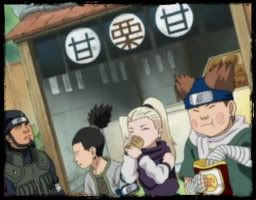 The Amaguriama (甘栗甘; Literally meaning "Sweet Chestnut Sweetness") is a popular sweet shop in Konohagakure located on Kiyamachi Dori that specializes in chestnut candies, such as chestnut jellies and jams, and roasted-chestnuts. The shop serves many other sweets like dango, mame-daifuku, manjū, and sweet bean paste. The Amaguriama has two shops in Konoha: one on Kiyamachi Dori and one located in the Hot Springs District. The first shop allows customers to eat outside, while the second shop allows them to eat outside or inside. Owner: Dan (旦) Menu: Under Construction
Daifuku:
A Japanese confection consisting of a small round mochi (glutinous rice cake) stuffed with sweet filling, most commonly anko, sweetened red bean paste made from azuki beans. Daifuku comes in many varieties. The most common is white-, pale green-, or pale pink-colored mochi filled with anko. These come in two sizes, one approximately the diameter of a half-dollar coin, the other palm-sized.
Price:
Heal:
Anmitsu:
A Japanese dessert that has been popular for many decades. It is made of small cubes of agar jelly, a white translucent jelly made from red algae or seaweed. The agar is dissolved with water (or fruit juice such as apple juice) to make the jelly. It is served in a bowl with sweet azuki bean paste or anko (the an part of anmitsu), boiled peas, often gyūhi and a variety of fruits such as peach slices, mikan, pieces of pineapples, and cherries. The anmitsu usually comes with a small pot of sweet black syrup, or mitsu (the mitsu part of anmitsu) which one pours onto the jelly before eating. Anmitsu is usually eaten with a spoon and fork.
Price:
Heal:
Botamochi:
A springtime treat made with sweet rice and sweet azuki (red bean) paste. They are made by soaking sweet rice for approximately six hours. The rice is then cooked, and a thick azuki paste is hand-packed around pre-formed balls of rice.
Price:
Heal:
Hanabiramochi:
a Japanese sweet (wagashi), usually eaten at the beginning of the year. Hanabiramochi are also served at the first tea ceremony of the new year. The exact shape of hanabiramochi is strictly defined by tradition. The white mochi covering is flat and round, folded over to form a semicircular shape, and must have a pink color showing through in the center of the confection, fading to a white at the edge. Unlike a daifuku, the mochi must not completely seal the insides. In the center of a hanabiramochi is a layer of anko, a sweet bean paste, commonly the white kind made from sweetened mung beans. In the very center is a thin strip of sweetly flavoured gobo (burdock), which protrudes from the mochi on both sides.
Price:
Heal:
Sakuramochi:
A variety of wagashi, or Japanese confectionery consisting of a sweet pink mochi (rice cake) and red bean paste, covered with a leaf of sakura (cherry blossom). The style of sakuramochi differs by region. Basically, the east of Japan such as Tokyo uses shiratama-ko (白玉粉?, rice flour) and the west side such as Kansai uses dōmyōji-ko (道明寺粉?, glutinous rice flour) for batter.
Price:
Heal:
Drinks:
Green Tea:
A tea made solely from the leaves of Camellia sinensis that have undergone minimal oxidation during processing.
Price: 2 ryo, 1 post
Heal: 20% MHp
Ice Tea (Special):
A form of cold tea, usually served in a glass with ice. It may or may not be sweetened.
Price: 2 ryo, 1 post
Heal: 20% Hp
|
 |
 |
|
|
|
|
|
|
|
|
|
|
|
|
|
|
|
 Posted: Sun Aug 05, 2012 12:31 pm Posted: Sun Aug 05, 2012 12:31 pm
Yakiniku Q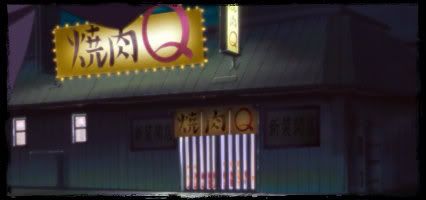 The Yakiniku Q (焼肉Q, Yakiniku Kyū) is the favourite Korean, Gyū-Kaku-style yakiniku restaurant of Konoha's citizens that is located in Konohagakure. Its salted beef tongue with Welsh onion (ネギタン塩, negi tanshio) is a very popular dish in the village. The original Yakiniku Q was destroyed but it was rebuilt and stands to this day. The restaurant is large with wide windows, multiple green-seated booths, though some tables allow customers to sit down on the floor with green cushions as their seats, menus plastered on the walls, and due to their Gyū-Kaku-style, each table has a charcoal brazier built in the center and is equipped with tongs for cooking, since the Gyū-Kaku form of dining is when the customers cooked their own food after they ordered the food raw. Owner: Serizawa Matsu (芹沢 松) Menu: Under Construction
Vegetarian set:
Assorted vegetables for grilling including peppers, asparagus, shiitake mushrooms, onions, carrots, etc. Served with a drink and vegetable side dishes (beansprouts, kimchi, spinach, etc.)
Price: 5 ryo
Heal: 15% Hp
Assorted beef set:
Shortribs (kalbi), ox tongue, shoulder, liver, heart, tripe, tail. Served with a drink and vegetable side dishes (beansprouts, kimchi, spinach, etc.)
Price: 7 ryo
Heal: 20% Hp 10% Cp
Deluxe beef set:
Shortribs (kalbi), ox tongue, shoulder, loin, and harami (tender meat around the diaphragm). Served with a drink and vegetable side dishes (beansprouts, kimchi, spinach, etc.)
Price: 8 ryo
Heal: 20% Hp, 15% Cp
Pork belly set:
Premium pork belly. Served with a drink and vegetable side dishes (beansprouts, kimchi, spinach, etc.)
Price: 6 ryo
Heal: 15% Hp, 10% Cp
Super deluxe set:
Premium pork belly, premium kalbi, premium sirloin strips, chicken, squid, and shrimp. Served with a drink and vegetable side dishes (beansprouts, kimchi, spinach, etc.)
Price: 10 ryo
Heal: 25% Hp, 25% Cp
Shushuya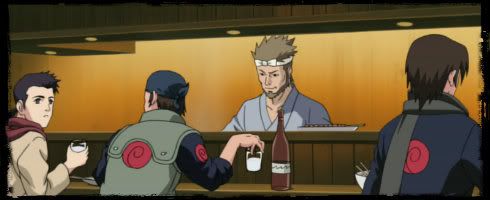 The Shushuya (酒酒屋; Literally meaning "Sake Sake Store") is a Japanese restaurant/pub in Konohagakure that sells their own brand of choice sake and serves large-platter cooking, when all the food is put on a single large plate. Its sake (日本酒, nihonshu) and yakitori roasted on a charcoal fire (炭火焼き鳥, sumibi yakitori) are very popular. The restaurant is large with pillars that supports the building, high ceilings with multiple small lights, a bar with stools that display most of their alcohol, and multiple wooden booths for the customers to sit in. Owner: Tange Shunsho (丹下 春曙) Menu: (For Alcohol you must roll a fort save to prevent the drunk status) Coming Soon
Inechi Brand
Konoha Ichiban:
Made with rice polished to a rating of 50% this brew is of the Daiginjō-shu (Very Special brew) quality rating. It comes in at 30% Alcohol by volume, making this the strongest brew that the Inechi family offers. Due to the wartime status of Konoha, and the amount of rice lost during the polishing process this brew is currently being produced in very low quantities, thus it's price is unusually high during the current times.
Price: 40 ryo for a 700 ml bottle
Effects: 40% Hp, 40% Cp
Shiroi Ame:
A creamy sake, named "White Rain" for it's mixture of white cream and the blue tint of the alcohol. During the production of Shiroi Ame, the rice is polished to 60% putting it in the Junmai Ginjō-shu (Pure rice, Special brew) category. The alcohol rating is 22% by volume.
Price:
Heal:
|
 |
 |
|
|
|
|
|
|
|
|
|
|
|
|
 Posted: Wed Jan 16, 2013 6:20 pm Posted: Wed Jan 16, 2013 6:20 pm
Inechi Shironaegi 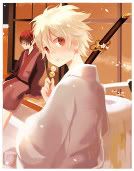 Hp: Hp: 50 / 50 Cp: 75 / 75 MHp: 60 / 60 Shiro walked groggily down the street as he yawned. He'd had the same strange dream as previous nights. The one where he woke up underneath a dead tree, surrounded by swords stabbed into the ground, and the ravens just stood around watching, and waiting. It of course caused him to awake early and instead of hanging around the house, he left his mom a note and headed out for the academy. With how tired he was, the boy felt like he needed a pick me up, so he headed to Amaguriama for a cup of tea. Shiro walked into the small stand, and greeted Dan, before asking for a hot cup of green tea and handing over two ryo. He only had to wait a few minutes before Dan handed over a small ceramic cup filled with green tea. Shiro gave his thanks and then stood outside as he began to quietly drink his tea. It must have looked quite weird to anyone walking by, a boy wearing clothes matching the historic look of Senju Tobirama, two bokken tucked into his cloth belt, and quietly drinking tea in the early morning. When the boy was finished he turned the cup back in and left for the academy. [exit to Academy]
|
 |
 |
|
|
|
|
|
|
|
|
|
 |
|
|
|
|
|
|











